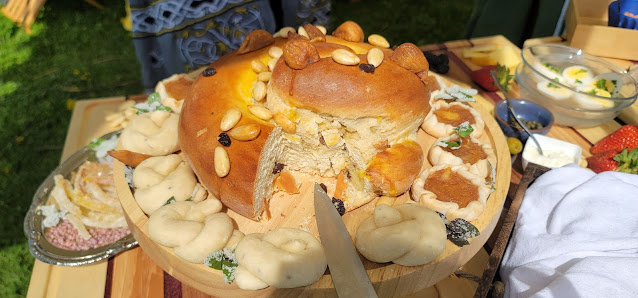Served July 9, 2022, for Aveline de Ceresbroch
Earlier this month I had the opportunity to cook for a dear friend and prepare a dayboard for the Push for Pennsic event held in my hometown of Troy, Ohio. The event was hosted by the Marche of Havenhold. This was a fun meal to put together and I am grateful for the opportunity to have done it. Thank you Aveline for asking :-) I was able to work with a few recipes that I did not think I would be able to do on a much larger scale. I learned quite a few new things, and, several recipes will be making an appearance again!
Most of the recipes can be found in "The Opera of Bartolomeo Scappi". However, two of the recipes are found in Bartolomeo Stefani's "L' Arte di ben cucinare", available for free on Google Books at the link in the title. I had to translate from the original language into English, and then construct the recipe. Lastly, Project Gutenberg's "A Book Of Fruits And Flowers" by Anonymous supplied another recipe.
The menu is below:
Uva Fresca di Piu sorti - grapes of all manners - Scappi
Mandorle e noci fresche -Fresh walnuts and almonds -Scappi
Mostaccioli a la Romana - sweet cake - Del Turco
Ingredient list - sugar, flour, almond flour, egg yolk, cinnamon powder, opt: dried fruit
Biscottini di zuccaro - Sugar Biscuits - Stefani
Ingredient list - egg white, sugar
Preparare una gattafura di cipolle alla genovese. - To prepare Genevese Onion gattafura (tart) Scappi
Ingredient list - pastry dough (whole wheat and white flour mix, oil, salt & water), fresh mozzarella balls, onions, vinegar, salt and pepper
Vaccina salpresa alessata, servito con petrosemolo Salted pressed beef, boiled served with parsley - Scappi
Ingredient list: Beef, salt, pink salt, coriander, black pepper, garlic powder, fenne
Per cuocere Broccoli asciutti. - to cook dry broccoli - Scappi
Ingredient list - broccoli, olive oil, garlic, orange juice, salt, and pepper
Per far minestra di Lenti secche - To prepare a thick soup of dried lentils - Scappi
Ingredient list - lentils, garlic, pepper, salt, olive oil, lemon, fresh herbs
Insalata di arance tagliate a fette, servite con zucchero e acqua di rose - Sliced orange salad with orange flower water and sugar - Scappi
Ingredient list - oranges, orange flower water, lemon juice, dates, mint
Cascio - A Selection of Cheese - Manchego, White Cheddar & Gouda
Per preparare un twist ripieno. - To prepare a filled twist. - fruit stuffed pastry - Scappi
Ingredient list - currants (or raisins), dates, red wine, sugar, cinnamon, nutmeg, cloves, rosewater, flour, yeast, eggs, butter, salt
Conditi, & confettioni a beneplacito Comfits and candies to one's taste - Scappi
Spanish Wedges
Marzipan flavored with Quince
Quince Paste
Candied Angelica, Orange, Ginger, and Lemon Peels
Figs in the French Fashion
Sources



